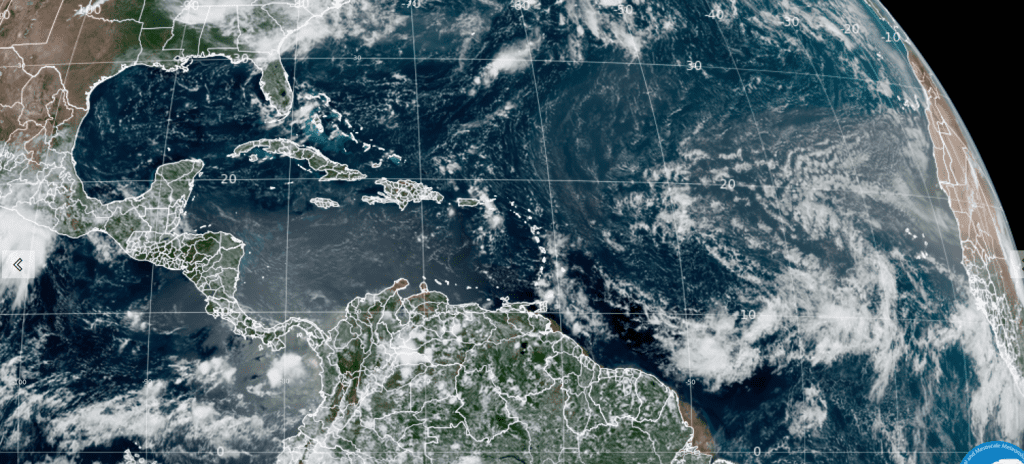No Rain, More Triple-Digit Heat Forecast through Late Next Week
AUG. 4, 2023
The current pattern of extremely hot temperatures and no rain is showing no signs of backing down anytime soon. The culprit remains the large, powerful, and stubborn heat dome located over the south central and southwestern U.S. This summer’s jet stream pattern has more or less locked the heat dome in place over our area, and the latest forecasts indicate it might be another 2-3 weeks, or even longer, before we see noticeable changes in this extreme pattern.
Friday’s analysis showed the center of the heat dome was located over Southeast Texas, between Austin and Houston. Sinking air around the dome center will cause a sunny sky, a very stable atmosphere, and very hot temperatures. For those that like to keep track, forecast solutions call for the center of the heat dome to shift west to the Desert Southwest this weekend, then return to South Texas around the middle of next week. The center of the heat dome is then predicted to move back to the Desert Southwest next weekend and remain out west beyond the middle of the month. Despite the center of the heat dome moving away and then moving back over our area, little overall change in the very hot and dry pattern can be expected through next week and next weekend.
- High temperatures Friday through Monday are forecast to be near 103-106 degrees across the Hill Country and Central Texas regions, and near 98-102 degrees across the coastal plains.
Slightly hotter temperatures are predicted for the Hill Country and Central Texas regions next Tuesday through Friday as the center of the heat dome moves back to South Texas and becomes a bit stronger.
- High temperatures next Tuesday through Friday are forecast to be in the range of 103-108 degrees across the Hill Country and Central Texas regions, and near 98-102 degrees across the coastal plains.
Next weekend, continuing into the week of August 14th, high temperatures are predicted to lower about 2-4 degrees as the center of the heat dome moves out west and the overall heat dome weakens slightly. High temperatures are forecast to be near 100-103 degrees across the Hill Country and Central Texas regions, and near 98-100 degrees across the coastal plains.
No rain is predicted for the Hill Country or Central Texas regions through late next week. Next weekend into the following weekend, a few isolated sea breeze showers may begin to develop as the heat dome weakens slightly.
Elevated to Near-Critical Fire Weather Conditions to Continue through the Weekend
The combination of critically to extremely dry fuels, breezy afternoon winds at 10-15 mph, and minimum relative humidity levels of 20-30 percent have supported the ignition of wildfires with high resistance to control over the last several days, and similar conditions are forecast to be in place this afternoon and through the weekend. The latest forecasts from the Texas A&M Forest Service (TFS) call for continued persistence of the critically to extremely dry fuels through this weekend. Everyone is urged to exercise extra care with any outdoor activities that could inadvertently ignite a wildfire.
The National Weather Service has posted a Red Flag Warning for Llano, Burnet, Williamson, Gillespie, Kendall, Blanco, Hays, Travis, Bastrop, Bexar, Comal, Guadalupe, and Caldwell counties from noon Friday through 9 pm Friday evening. A Red Flag Warning means critical fire weather conditions are either occurring now, or will shortly. The combination of strong winds, low relative humidity, and warm temperatures can contribute to extreme fire behavior.
Tropical Weather Outlook
Weather conditions are quiet across the entire Atlantic basin. There are no systems in place which pose a threat for tropical development over the next seven days.

The Perseid Meteor Shower Will Peak Next Weekend
Have you seen any early Perseid meteors yet? A few Perseids trickle in starting in late July, then they build for a couple of days toward their peak, which this year is predicted for the night of August 12-13. At that time, the sky will be moonless for perfect meteor-watching conditions. The weak, long-lasting Delta Aquariid shower is still somewhat active this week. For both showers, the later in the night the more abundant the meteors should be.
I’ll post more details about the peak of the Perseid meteor shower and how to view them next week.
Bob


Social Media